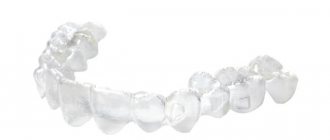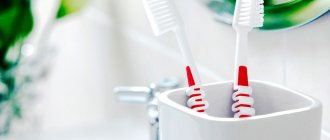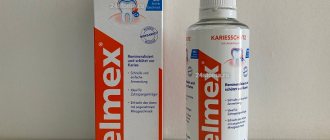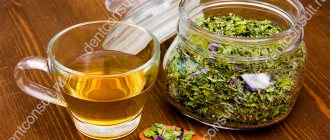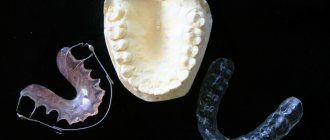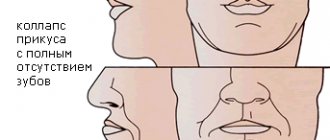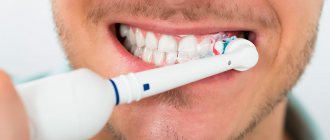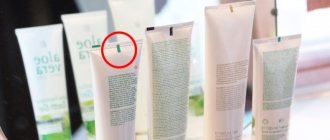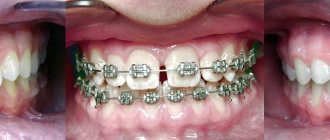It will be interesting to know how to cook a mouth guard for boxing for people who are passionate and professionally involved in this spectacular sport. Cooking lovers can relax; this material is for real athletes and boxing fans. A boxing mouth guard is a device used to protect a boxer's teeth and jaw. Mouthguards for protecting teeth come in 2 types, single and double. The single-jawed one is fixed only on the upper jaw, while the double-jawed one has a hole, which helps to facilitate the athlete’s breathing. If the preparation is carried out incorrectly, then the mouth guard will have weak teeth marks; such a device will not be able to provide good protection.
Why cook kapa?
A mouth guard is a special rubber band that a boxer holds in his mouth during a fight. This is a mandatory part of every boxer's equipment. Its main function is protection from strong impacts and various types of injuries.
There are several types of this accessory:
- single-jawed;
- two-jawed.
The most popular are the single-jawed species.
Many novice athletes do not know why to cook the product, since it is sold already in finished form. The answer to this question is very simple - thanks to the cooking procedure, the rubber takes the shape of a jaw. And this accessory should fit snugly to the jaw. The degree of protection of teeth during combat depends on this.
Reasons for the development of pathology
Snoring is a rattling sound that occurs during deep sleep as a result of a disruption in breathing. The consequence of disturbances in the respiratory system is relaxation of the muscle structures of the pharynx and the back of the palate.
For this reason, the inhaled air flow moves through the upper breathing apparatus incorrectly, which causes a special sound.
Interesting to know! According to statistics, about 47% of men and 28% of women suffer from regular snoring.
Let's look at the common causes of snoring:
- Curvature of the nasal dividing plate.
One of the most common causes of snoring, which affects people of all ages. The plate dividing the nasal cavity into two equal halves is deformed under the influence of trauma. The resulting curvature becomes an obstacle to the normal passage of air flow. In addition, the violation provokes the development of chronic rhinitis, which further aggravates the problem. - Tonsillitis (damage to one or more tonsils). Hypertrophy of the palatine tonsils is an infectious disease caused by bacterial or viral infections. Inflammatory enlargement of the tonsils creates a barrier in the lumen of the nasopharynx. During difficult breathing, muscles vibrate and vibrating sounds appear.
- Polyposis of the initial part of the respiratory apparatus.
Polyps in the nasal cavity are benign, round-shaped formations. During the growth stages, they gradually block the nasal passages, making it difficult to breathe freely. The disease affects the adult category of patients. The problem is aggravated by the fact that it is quite difficult to recognize the disease in the early stages of development - polyps make themselves felt when their size causes not only snoring, but also nasal congestion. - Proliferation of lymphoid tissue (adenoid vegetations). The pathological condition leads to an enlargement of the pharyngeal tonsil and problems in respiratory functions. More often, adenoids are detected in children. The disease occurs due to the entry of an infectious agent into the body or due to allergic reactions. An increase in lymphoid tissue can be recognized by the appearance of very noisy breathing.
- Rhinitis (runny nose).
The disease is manifested by swelling, nasal congestion, the appearance of mucus and develops against the background of the proliferation of microbes or due to infection with a virus. In some cases, the disease occurs due to hypothermia. The most common cause of snoring is the catarrhal type of rhinitis. It can be recognized by the occurrence of swelling of the nasal mucosa, which narrows the lumen of the nasal passages, making breathing difficult. - Alcohol abuse, taking sleeping pills and psycholeptics. During night sleep, the muscles are in a state of relaxation. The muscular structures of the respiratory apparatus are no exception. Psychotropic drugs and alcohol-containing drinks further relax the organs formed by muscle tissue, which is why a person who is in the stage of alcoholic intoxication snores very loudly. The problem will disappear if you get rid of the bad habit.
- Deformation of the nasopharynx due to age-related changes. Over the years, muscle tone changes. In addition, a person may suffer from chronic infectious diseases of the upper respiratory tract. For this reason, when a person lies on his back and falls asleep, the muscles of the pharynx sag. This condition causes low-frequency vibrations of the velum and the lesser process (uvula).
- Overweight. In obese people, fatty structures in the neck area develop greatly. This leads to compression of the upper respiratory tract, which leads to oxygen starvation of the body. Over time, obese people develop obstructive sleep apnea syndrome, which is characterized by temporary cessation of breathing during the period of night rest.
- Congenital factor. A large tongue, elongated minor process or palate can cause snoring sounds.
In some cases, rhonchopathy develops for the following reasons:
- body fatigue;
- disturbance of emotional calm;
- drug intoxication;
- sleep on your back or stomach.
To understand why you need to wear mouthguards after removing braces, you need to know the basics of the anatomy of the maxillofacial apparatus. Many ignorant patients do not understand why this step cannot be avoided. After all, all the problems are behind us, those around us admire the attractive smile of the owner of straight and white teeth. And then, it turns out, everything can change again for the worse. So what is the reason?
It's all about the structural features of the teeth. The teeth are surrounded by a space in which the ligaments and vessels that hold them in the jaws are located. With the help of braces, the ligaments are stretched and the teeth move in the jaw in the right directions. This is associated with a feeling of pain in the area of the fixed teeth during the period of bite correction.
Stretched ligaments strive to return the teeth to their original position, but dental structures interfere with them. However, after removing the braces, nothing prevents the ligamentous apparatus of the teeth from taking their original positions. It is to inhibit this natural process that special devices or mouth guards are used.
We suggest you read: Black plaque on teeth in children - causes and treatment
Cooking technology
Having chosen a mouth guard for boxing, you then need to independently carry out the procedure of cooking it, or rather boiling it. The whole process is simple to perform, just follow the following sequence of actions:
- Boil water in a kettle or ladle.
- Take two containers and pour boiling water into one, and fill the second with clean cold water.
- First place the product in a vessel with boiling water and leave for exactly one minute. There is no need to overexpose it.
- After the specified time has passed, take out the mouthguard, place it between your jaws and bite down as hard as possible. While in boiling water, the rubber will soften well and easily take on the desired shape.
- Leave the tray in your mouth for about five minutes.
- After the specified time has passed, remove the mouthguard and place it in a container filled with cold water. This is necessary for the rubber to harden.
Duration of treatment
The duration of mouth guard therapy for TMJ dysfunction is determined individually and depends on the severity of the pathological process. Treatment may take several weeks or months. In rare cases, a year or more. It is necessary to visit the clinic periodically to monitor the progress of treatment and make adjustments to the condition of the surface of the structure. For example, you may need to add or remove excess material.
The first results will be noticeable within a few days. The signs of TMJ dysfunction begin to weaken and then completely disappear. The load on the ligaments is reduced and their functionality is restored. The teeth are aligned and the muscles are relaxed. With bruxism, the abrasion of enamel decreases. Overall, the condition of the oral cavity improves significantly.
Sometimes, a mouthguard is only part of a comprehensive treatment. In such cases, you can only wear it at night. If this is the main method of therapy, then you need to wear it at least 17-20 hours a day.
The achieved results are always consolidated with the help of orthodontic or restorative treatment.
According to patient reviews, after therapy with a joint cap, the symptoms of TMJ dysfunction decrease or completely disappear in 85% of cases. The device helps relax the jaw and puts the joint in its “right place.”
Mouthguard fitting
As the temperature rises, the rubber softens. To fit it correctly, you need to remove it from boiling water, place it in cold water for one second and immediately fix it on the upper jaw.
There are several nuances to fitting a mouth guard:
- First the back part is fixed, and then the front;
- after the mouthguard is completely seated, it is pressed with your fingers to repeat the shape of the teeth and jaw;
- if a double-sided mouthguard is being adjusted, you cannot remove the plug from the holes until it takes the form of a bite;
- If it doesn’t work the first time, you can repeat the entire procedure.
If the mouth guard is correctly selected, it fits tightly on the upper jaw and does not require additional fixation.
There are two types of mouthguards - made of thermoplastic or silicone. The latter option does not require special adjustment and is easily fixed on the upper jaw, and no cooking is required.
Thermoplastic mouthguards are suitable for the classic brewing procedure. But you should always take into account the manufacturer's recommendations.
Production process
A joint mouthguard is a removable covering over the teeth. It is made individually for each patient based on the parameters of his dental apparatus. This approach ensures good fixation of the product, comfortable wearing and quick adaptation. Hypoallergenic plastic is most often used for production. It has an elastic structure and extraordinary softness. Acrylic or silicone can also be used.
Device manufacturing algorithm:
- An impression is taken of the upper and lower jaws;
- a model of the future design is created on the computer;
- a plaster mold is made;
- wax modeling of the plate is performed;
- the surface of the device is processed and polished.
Thanks to its special shape, the mouth guard neutralizes muscle spasms, stretches the temporomandibular joint ligaments, eliminates pain and relieves discomfort.
Rules for preparing mouthguard
Before you start cooking kapa, you need to carefully study the recommendations that will help you avoid common mistakes. There are several important rules:
- if the product has been overcooked, it must be thrown away immediately;
- When placing a product in hot water, it must not be completely immersed - it is important that it floats on the surface of the liquid;
- When squeezing your teeth to give the mouthguard the desired shape, you cannot move your jaw; it is important to firmly fix the product and hold it.
When the mouthguard is prepared correctly, it:
- has clear prints;
- holds tightly;
- does not create discomfort during use.
Question to an expert
Which mouth guard is best for a beginner?
The ideal choice is a two-jaw mouth guard. This model is suitable for both beginner athletes and women. The product provides maximum jaw protection at the initial level of training.
Types of devices
For snoring relief to be truly effective, it is important to choose a device that is convenient in all respects for the patient. Today there are many varieties of mouthguards with different characteristics.
Let's consider the features of the species in detail:
- Individual. Without a doubt, a mouthguard made in accordance with the anatomical features of the patient will be the best option when compared with a purchased model. If the product is used according to indications, its functions are performed in the best possible way. The only negative is the high cost, which can reach more than 6 thousand rubles.
- Ready. This product is not adjustable. Experts recommend this type to evaluate the effectiveness of the mouthguard in a particular case, and the result is determined after 14-20 days. If the dynamics are positive, a permanent product is manufactured according to the individual characteristics of the patient.
- Titrated. Such products are particularly effective in comparison with the types described above. They allow you to independently adjust the displacement of the movable jaw, increasing wearing comfort. Doctors advise titrating the displacement upward, gradually increasing the value. If discomfort occurs, the device can be titrated to its original position.
- Heat labile. Such mouthguards are made from polymer materials and sold in pharmacies in the form of blanks. This type of tray can be heated, softened and modeled independently. Disadvantages include a short service life, possible difficulties with installation and difficulties with correction.
- Neuromuscular. A new type of anti-snoring device that requires painstaking teamwork of various specialized specialists to manufacture the product. This type of mouthguard can not only act symptomatically, but also eliminate a number of causes of snoring.
According to practice, titrated devices are distinguished by increased efficiency and ease of wearing.
How effective and invisible are 3D Smile aligners on the patient’s teeth?
In this post we will talk about OrthoSnap aligners.
Features of mouthguard care
This is an important part of using this accessory. It’s easy to care for your mouth guards by following these tips:
- need to be stored in a special container that will protect from dust and dirt;
- after the mouthguard has been removed from the jaw, it must be rinsed with plenty of running water;
- if necessary, it is allowed to periodically clean the product with toothpaste and a brush;
- Boiling water cannot be used for sanitization; for this purpose, special pharmacological agents are used, which are available in a wide range in pharmacies.
Contraindications
Anti-snoring mouthguards are made from safe, hypoallergenic materials, but even despite this, experts do not recommend their use to patients in the following conditions:
- inflammation of the gums;
- loose teeth;
- diseases attacking periodontium;
- malocclusion;
- problems with the oral mucosa;
- chronic sinusitis;
- psychoneurological disease accompanied by convulsive attacks;
- mental disorders;
- complete or partial absence of teeth;
- wearing a complete denture;
- allergic reactions to silicone material;
- advanced carious process;
- obstructive diseases of the bronchial tree;
- obesity with an increase in body weight of more than 20%;
- inflammation of the nasal mucosa;
- bleeding gums;
- rehabilitation period after implantation;
- gag reflex when trying to install the device.
It is important to note that mouthguards are prohibited from being installed on children of a younger age group.
Common mistakes
The process of brewing burls does not always go without problems. It is difficult to cook a mouthguard incorrectly, but this happens when the product is placed in water at the wrong temperature;
- the accessory becomes hard when it is placed in cold or insufficiently heated water, as well as if it is kept at high temperatures for a long time (about 100 degrees Celsius);
- pimples appeared - the product was in boiling water for too long;
- if a thin and cheap burl is brewed, it can literally melt; to prevent this from happening, you must strictly adhere to the established temperature conditions and the time the product is in the water.


